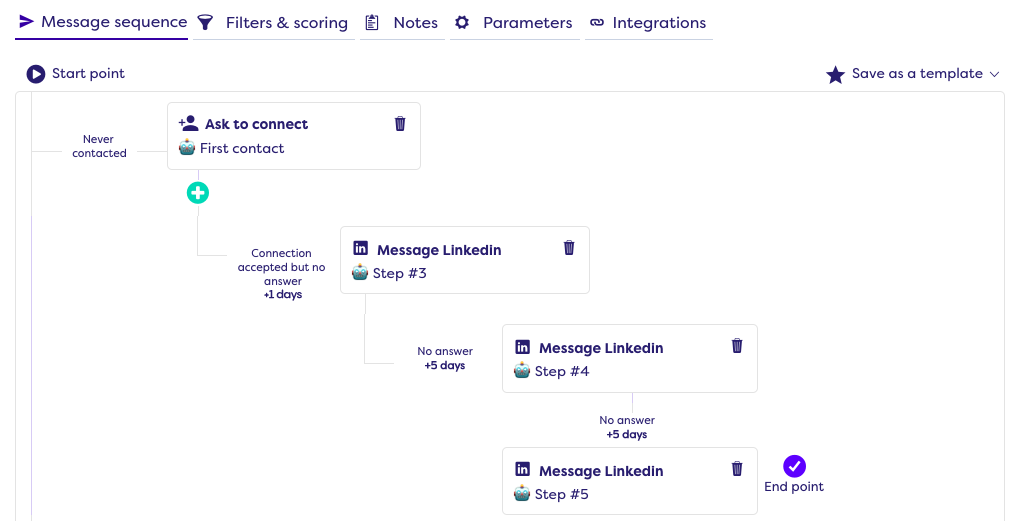With the current talent shortage in many industries, it's become more important than ever to explore all options for sourcing candidates.
That's where outbound recruiting comes in.
In this article, we'll give you everything you need to know about outbound recruiting, from what it is to the different types of strategies you can use.
What is Outbound Recruitment?
Outbound recruiting is a proactive approach to sourcing candidates. Rather than waiting for talents to apply to your job postings or come to you, outbound recruiting involves actively seeking out and approaching candidates who might be a good fit for your open positions.
It can include reaching out to passive candidates who are not actively looking for new opportunities, as well as those who may not have applied to job postings or otherwise expressed interest in a position.
This approach involves searching for talent through various channels, such as social media, professional networks, referrals, and events. One of the goals is also to build relationships with potential candidates even before a job opening arises.
Inbound Recruiting VS. Outbound Recruiting
Inbound recruiting is a strategy of attracting candidates to apply for a job through a company’s website, social media, or job boards. It is a reactive approach that relies on job postings and brand awareness to generate applications.
Outbound recruiting, on the other hand, is a proactive strategy. It focuses on actively reaching out to potential candidates and building relationships with passive profiles before a job opening arises.
Both approaches have their advantages and disadvantages. But you can make them work together to create a competitive talent acquisition plan.
The Advantages and Downsides of the Practice

The main advantages of outbound recruitment are:
- Reaching a wider pool of qualified candidates, including those who may not have otherwise applied for a position
- Getting better quality of hire thanks to a more targeted approach to profiles who are a better fit for your specific needs
- Reducing time-to-hire and cost-per-hire as you don’t solely rely on job postings
- Having a competitive advantage in finding top talent before your competitors
- Building your employer brand and reputation by demonstrating that you are proactive and invested in finding the best talent
While you will find great benefits in outbound hiring, there are still some downsides to consider:
- Can be time-consuming and resource-intensive, as it involves a more proactive and personalized approach
- Can lead to more rejection than inbound recruiting, as not all candidates you reach out to will be interested or available.
- May not be effective for all types of positions, as some candidates may only be interested in applying to job postings
- New technology adoption can be difficult if you are not comfortable with digital tools such as a recruitment CRM
The Main Components of an Outbound Hiring Strategy
The 3 main approaches to outbound sourcing
Cold outreach: This involves sourcing potential candidates who you have not had any previous contact with.
Warm outreach: This involves reaching out to candidates who have previously interacted with your company, such as through events or past applications.
Referral-based outreach: This involves leveraging your current employees or network to find potential candidates who might be a good fit.
The Channels
There are several different channels you can use in an outbound hiring strategy, including:
- Talent sourcing: using tools and platforms like LinkedIn Recruiter or Github to search for potential candidates
- Social media recruiting: using social media platforms like LinkedIn, Twitter, or Facebook, to engage with talents
- Cold email campaigns: sending personalized emails to talented profiles who match your company's hiring criteria
- Referral programs: incentivizing current employees to refer qualified candidates for open positions
- Events Recruiting: attending job fairs, conferences, and meetups to connect with potential hires
The Message
Whatever approach or channel you use, the offer you make must be clear, transparent and personalized. Recruitment is like a sales job where you need to target the right candidates with the right offer at the right moment.
You must show your potential candidates that you value their unique profile and that your company has great perks to provide in return.
That’s why when reaching out, especially for cold outreach, make sure to include :
- What drew your attention in their profile that made you reach out
- The role you offer, its missions, salary range and growth opportunities
- The work environment, the company’s values, culture and benefits
- A call to action to schedule an interview or, at least, get an answer
When doing social media or email outreach, you must focus on getting responses.
Why ? Because doubling the response rate will reduce the workload by four times. This is because a better response rate means more interviews for the same volume of people contacted.
Secondly, doubling the response rate will result in better candidates. There is an adverse selection bias, where the best candidates are the least likely to respond. Therefore, improving the rate of positive responses by 10% to 20% is likely to result in better quality candidates.
Continuous improvement is crucial. The more you measure your results, test and continuously improve your messages, the higher the response rates, number of interviews and candidate quality.
Outbound Recruitment Tools
There are two main tools you’ll need to have your way in any outbound recruiting strategy.
LinkedIn Recruiter
LinkedIn Recruiter is the most known sourcing tool out there and for a reason : most professionals are on LinkedIn.
LinkedIn Recruiter helps you find suitable applicants more efficiently. It is a hiring platform that assists with finding, shortlisting, and managing candidates. The tool utilizes insights from LinkedIn's active community to reduce overall hiring time. You can also easily reach out to a large number of applicants using its bulk messaging capability.

Candidate Relationship Management System
Inspired from the infamous Client Relationship Management System, an alternative solution dedicated to recruiters was born : the Candidate Relationship Management System.
Leonar is one of them.
It will allow you to :
- Better target top talents by balancing LinkedIn Recruiter weaknesses.
- Automate and personalize your candidate approach and follow-ups through multi-channel outreach such as LinkedIn messages, Inmails and emails
- Centralized all your conversations in one place from every touch point you used with your potential candidates
- Manage your talent pools and organized them in lists to refer to
- Analyzing your campaigns’ performances through a dashboard presenting the most relevant data

The Main Challenges of Outbound Recruiters
While outbound recruiting can be an effective strategy for filling open positions, it can also present several challenges for recruiters, including:
- Developing a strategy by identifying the right channels and messages to reach potential candidates
- Building and maintaining relationships with passive candidates over time as it takes time and effort whereas some may be resistant to engage with recruiters
- Being data-driven: measuring the success and ROI of outbound recruiting efforts
- Ensuring compliance with the relevant data protection and privacy regulations, such as GDPR and the CAN-SPAM Act.
Conclusion: Outbound Recruiting is here to stay
Outbound hiring has become a necessity for companies looking for a competitive advantage in finding top talents. It won’t replace the traditional Inbound practices. However, it has the power to balance its weaknesses considering today’s recruitment issues.
By understanding the different types of hiring strategies, as well as their challenges and benefits, recruiters can make informed decisions about how to best approach sourcing candidates in their industry.
But as competition for top talent continues to increase and considering the continuous evolution of technologies and social media, outbound recruiting is likely to become even more important for any successful talent acquisition plan in the years to come.
.jpg)

.svg)



